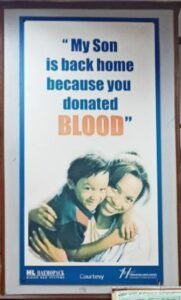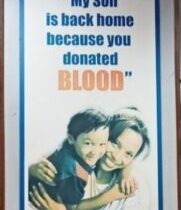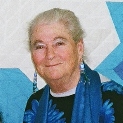Life-Giving and Life-Sustaining Blood
 My father was a life-long blood donor. His dedication to this service began when he was a young man. His younger sister developed a condition in which the platelets no longer held the blood inside her veins and arteries properly. She began to bleed internally. The only treatment was to give her blood and hope her body would begin to produce the platelets she needed before she died. Unfortunately, it did not. She died at the age of 18, the year before I was born.
My father was a life-long blood donor. His dedication to this service began when he was a young man. His younger sister developed a condition in which the platelets no longer held the blood inside her veins and arteries properly. She began to bleed internally. The only treatment was to give her blood and hope her body would begin to produce the platelets she needed before she died. Unfortunately, it did not. She died at the age of 18, the year before I was born.
In memory of his sister, Dad gave blood regularly for the rest of his life. He lived to be 93 ½ years old.
For Aunt Dolores, the reality of life-sustaining and life-giving blood was very immediate and intimate. For most of us, it’s much more of a theoretical, abstract concept.
As we celebrate the Solemnity of the Most Holy Body and Blood of Christ, we have the opportunity to reflect on the importance of blood to life and to our experience of the presence of Christ in our lives.
Our ancestors in faith, the descendants of Abraham and Sarah, were pastoralists. They raised sheep and goats and traveled with them from one pasture to another until a great famine led them to move to Egypt. There they grew in numbers, but always remembered that they were a separate people, with their own God. Eventually, after they had been enslaved, God sent Moses to lead them out of Egypt and back to the land promised to Abraham, Isaac, and Jacob. It was not an easy, peaceful transition.
To this day, we remember the events of the Exodus from Egypt. Plagues, storms, disasters, and the death of firstborn children of Egypt – all were part of the signs that led Pharaoh to allow them to leave. The Angel of Death swept through Egypt one night, but skipped the homes that had the blood of a lamb smeared around the door frame. This first Passover has been celebrated annually since that time. Jesus and his followers celebrated the Passover in Jerusalem at the end of his life. Three of the evangelists place the Last Supper and the institution of the Eucharist at the end of a Passover Seder.
St. Mark tells us about the preparations for that evening’s celebration and also about Jesus’ actions in taking the bread and giving it to all, saying, “Take it; this is my body.” He passed the last cup of wine around as well, saying, “This is my blood of the covenant, which will be shed for many.” (Mk 14:12-16. 22-26)
Since that time, we have shared this bread and wine in our celebrations of thanksgiving, our Eucharist. His words are repeated each time, including the instructions to “Do this in remembrance of me” which are found in another Gospel account. (Lk 22:19)
Thousands of words have been written, hours of thought, conversation, discussion, arguments, and energy have gone into the endeavor of reaching understanding of how this can be and exactly what is it that is happening/has happened through these words and actions. I do not pretend to have better answers than those who have come before me.
Nevertheless, I do want to reflect a bit on the idea of blood as life-giving and life-sustaining. Moses carried God’s words and instructions/ordinances to the people after his encounter with God on the mountain top. He told the people what God was asking of them and they agreed to do as they were instructed. So Moses wrote it all down for them and began this new formal relationship with a ritual, a ceremony, to make it all official.
Pillars were erected to represent all twelve tribes of Israel, young bulls were sacrificed. Some were burned completely as a sacrifice and others were only partly burned and eaten by the people as peace offerings. It was a sacred, sacrificial meal. Then half the blood of the sacrificed animals, which had been collected in bowls was poured out on the altar in sacrifice as well. The rest of it was sprinkled over the people. Our contemporary minds say, “Ewww.” But they believed that in blood, God’s life force was present. The Hebrew people did not and do not consume blood. When the blood was sprinkled over the people, it was a sign of the covenant relationship between the people and God. Life-giving and life-sustaining. (Ex 24:3-8)
For Jesus and those around him, the sacrifice of animals at the temple remained a reality. Part of his anger with those who administered the markets supplying animals for sacrifice was due to the fact that all too often the ordinary people were being charged too much to purchase the animals for sacrifice. It caused greater hardship than necessary.
So when Jesus spoke of his body and blood as signs of a new covenant, his friends immediately wondered what he meant by that. They didn’t suspect that he would rise from the dead. They didn’t even know that he would die the next day! There was a lot to sort out in the days, weeks, and years after these events. But the community continued to gather, pray together, and read the Hebrew scriptures that spoke of God’s love and the promise of a redeemer. And they broke the bread and shared the cup, as we continue to do today.
The author of the Letter to the Hebrews also reflected on this great mystery of the new covenant and the new high priest in the heavenly sanctuary. This new high priest does not need the sacrifice of animals and their blood. The blood of life, the life of God, has been shed to bring life to all, a share in divine life. The everyday ordinary blood of human and animal life no longer needs to be shed for this covenant. Another has shared the blood of life. (Heb 9:11-15)
Most likely we will never know how many people lived because my father shared his blood with them. I’m sure he has been thanked many times in his new life with the Lord by those who received his gift. I too thank him tonight as I write. I was wondering how to address these readings and this feast all day. And then this evening, after the dishes were washed and it was nearly time for bed, the memory of Dad and Aunt Dolores came to me. Life-giving, life-sustaining. Blood of life. Body to nourish us on our journey to everlasting life.
May we remember this week that we are sharers in the life of God. The Body and Blood of Christ we share are those of our God, become one of us and raising us to new life. Not a riddle to solve. Not a logical puzzle. A mystery to enter into. A cause for rejoicing.
Readings for the Solemnity of the Most Holy Body and Blood of Christ – Cycle B










